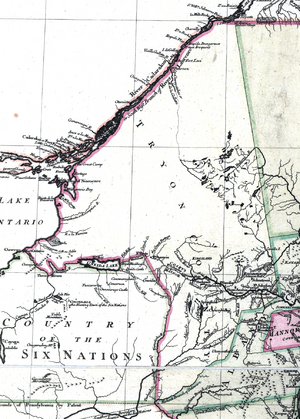Tryon County, New York facts for kids
Tryon County was a large area in the Province of New York when America was still a group of British colonies. It was created on March 24, 1772. The county was named after William Tryon, who was the last British governor of New York.
Tryon County was much bigger than any county you see today. Its eastern border was near the Mohawk River and went all the way up to Canada. To the north, it reached the St. Lawrence River. Its western border followed a line set by a treaty, going along rivers and Oneida Lake to Lake Ontario. This was because the Iroquois Confederacy, a group of Native American nations, still controlled lands further west. The main town, or "county seat," for Tryon County was Johnstown. Today, Johnstown is the county seat of Fulton County. The old courthouse and jail in Johnstown, built in the 1770s, are now famous historic places.
Tryon County was divided into five main areas: Mohawk, Palatine, Canajohorie, German Flatts, and Kingsland. The county's court and jail were built in Johnstown in 1772. Some of the first judges were related to an important figure named Sir William Johnson, 1st Baronet. These included his son, nephew, and son-in-law. Other judges were also important people in the area. When the American Revolution began, some of these judges supported Britain, while others supported the American cause.
Contents
Tryon County and the American Revolution
Early Tensions and Departures
In August 1774, just before the American Revolution started, some people in Tryon County formed a group called the Tryon County Committee of Safety. This group worked against people who supported Britain, known as Loyalists. Because of this, many Loyalists decided to leave the county and find safety in Canada. For example, Guy Johnson and many of his supporters left in May 1775. Sir John Johnson and his supporters also left in May 1776. By 1776, most Loyalists in Tryon County had moved away.
Impact of the War on the County
The war had a big effect on Tryon County. By December 1780, a survey showed that many farms were empty and not being used. About 354 families had left the county. In some areas, like Cherry Valley and Springfield, almost no one was left. Before the war, about 10,000 people lived in the county. The town of Schenectady became almost the edge of settled areas.
What Happened After the War
Renaming the County
After the American Revolution ended, the new state government of New York made a change. On April 2, 1784, the legislature voted to change the name of Tryon County. It was renamed Montgomery County. This was done to honor General Richard Montgomery. He was a general in the Continental Army who died during the Battle of Quebec in 1775. The legislature also renamed another county, Charlotte County, to Washington County.


